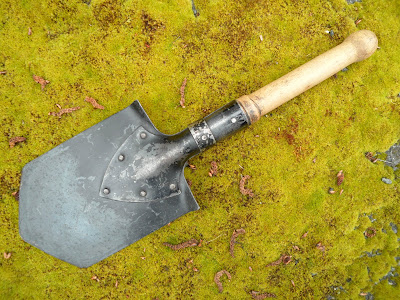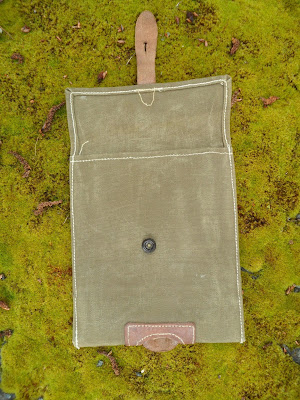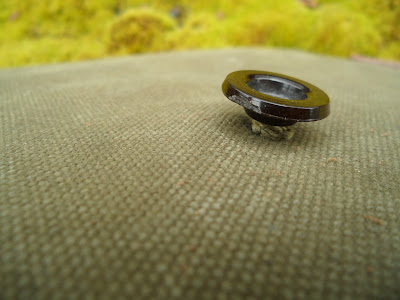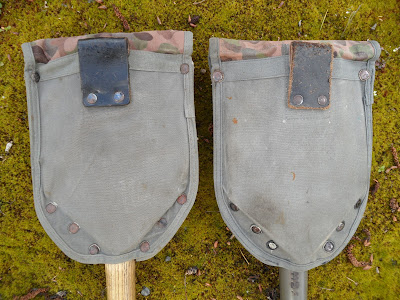Since I have been adding a number of new shovels and tools to the collection lately, I figured I ought to do a quick inventory to see if I have missed any for the blog. Well, I found one!
I added this shovel and cover to the collection several years ago, and never got around to showing it off, so here it is. This is a Hungarian Army entrenching tool, from the early post-war, Cold War era.
I originally picked this shovel up without a cover. I later had the chance to pick up another post-war, Hungarian shovel, with a carrier, so I jumped right on that. You can never have too many shovels and with the added bonus of a hard to find, original cover included, I just couldn't say "No". The shovel ended up being a wonderful, Austro-Hungarian shovel from the WW1 era, that came with an original post-war Hungarian cover. A big score on two fronts: I got a rare WW1 shovel and a cover for my post-war Hungarian shovel! You can read about the Austro-Hungarian shovel story here:
http://sharky-fourbees.blogspot.com/2015/10/austro-hungarian-ww1-trench-spade-model.html
Now that you have a bit of the background story, let's take a look at my post-war, Hungarian shovel.
This shovel is known as the Model 1950, or M50 shovel. In 1950, Hungary redesigned and updated most of their uniforms and equipment for the Army. The field shovel was reworked and given a shorter, and thicker handle, that was carved thinner in the mid section for gripping. The blade stayed the same shape, and a new style cover was adopted.
The cover for this new Model 1950 shovel was patterned after the Soviet style of covers, and is nearly identical in every respect. You can compare the Model 1950 to the older Model 1910 shovel by viewing the link I posted above.
The blades on these post-war shovels all have the same number code. The stamped number is often mistaken as a date, but it is actually just the "stock number", or something like that.
The Hungarian Army used these shovels into the 1970's to 1980's, when a new style of folding shovel was adopted. Like most communist block countries in the area, the old gear was placed into long term storage for the "Apocalypse". For the last 10 years or so, the old Hungarian surplus has been finding its way onto the market, and into bunkers like mine!
Let's take a look at this shovel and cover.
Tuesday, April 18, 2017
Friday, April 14, 2017
Austrian Army Folding Shovels, 1957, 1967, with camo covers, Österreichischen Bundesheer Klapspaten, HBA
We just got back home to the beautiful, Pacific Northwest, after a week long trip down to Northern California. Since we were in the neighborhood, we just had to stop off at our favorite European Military Surplus Importer's warehouse: Swiss Link, in Paradise, California. While we were there, we just had to load up the back of the Jeep with some amazing treasures, including these two Austrian Army folding shovels............
These two shovels were "hand selected" from a big bin of shovels in the wholesale warehouse. Both of them included the camo covers.
One Shovel is dated 1957, and the other 1967. They both have found a new home in the bunker. (By the way, I have an additional, extra shovel available for sale. Contact me via email or comment if you're interested!).
After WW2, Austria did not fare too well during the post-war occupation. After they were ravaged by the Russians, and occupied by the US, they finally regained their "independence" in 1955. Austria declared their "eternal neutrality" and re-started a new army (Defence Force), the Bundesheer. The new Austrian Army was equipped with US equipment, weapons, and uniforms, as well as their own "Germanic equivalent" to the US uniforms and equipment. It was no surprise that Austria manufactured, and issued their own version of the US M43 folding shovel.
These Austrian folding shovels were first issued during the first couple of years of the new Bundesheer's existence. The first camo covers were manufactured using the "new camo" pattern adopted in 1957. It is my guess that this is also the first year that these shovels were issued as well. The Austrian Army used this camo from 1957 until the 1970's. All of the camo was manufactured in the 1950's and 1960's. Since my two shovels are dated 1957 and 1967, and they have their original camo covers, this makes them some of the earliest of the old, post-war, Austrian equipment. Sometime in the late 1970's, the Austrian Army abandoned the use of camouflage for uniforms and equipment and adopted standard, OD Green for all military equipment and uniforms.
My first shovel is dated 1957, and has an unpainted handle. The metal on this shovel appears to have been repainted OD Green at some point, later in its use.
The second shovel is dated 1967, and is completely painted OD Green. The paint has worn away on the edges of the blade and the old, traditional, blackened steel finish is partially visible.
These Austrian shovels appear at first to be identical to the old WW2, US M43 shovels. However, on closer inspection, there are some significant differences. The first and most obvious, is the curvature of the blade. These Austrian blades are more curved from side-to-side and front-to-back, than the flatter, US shovels.
The blade adjustment and locking arrangement is also slightly different (and improved). Between the locking nut and the blade mount, there is a flat washer with two flat lugs. These lugs fit into the various notches in the blade mount-hinge. This allows for several additional angles as opposed to the "straight, 90 degree or folded" options found on the US shovels, and makes for a very secure lock-up.
There are also a few differences between the two of my shovels. Blade curves are slightly different and the handles are different lengths, and the handle ends are shaped differently. The handle rivets and seam in the handle mount sockets are in different locations as well. I am sure this is just manufacturing variation and not different model specifications though.
Both handles are marked HBA, which stands for Heeres Bekleidungsamt, or Army Supply Office in English.
Both of the camo covers are well marked, however, the dates are not clear. I suspect that they are both from the 1960's though.
Now that I've written a "novel", let's take a closer look at these two shovels and covers.
Shovel Number One: 1957
Shovel Number 2: 1967
Side-By-Side Comparison:
Shovel Covers:
These two shovels were "hand selected" from a big bin of shovels in the wholesale warehouse. Both of them included the camo covers.
One Shovel is dated 1957, and the other 1967. They both have found a new home in the bunker. (By the way, I have an additional, extra shovel available for sale. Contact me via email or comment if you're interested!).
After WW2, Austria did not fare too well during the post-war occupation. After they were ravaged by the Russians, and occupied by the US, they finally regained their "independence" in 1955. Austria declared their "eternal neutrality" and re-started a new army (Defence Force), the Bundesheer. The new Austrian Army was equipped with US equipment, weapons, and uniforms, as well as their own "Germanic equivalent" to the US uniforms and equipment. It was no surprise that Austria manufactured, and issued their own version of the US M43 folding shovel.
 |
| Austrian soldier in the 1960's. |
My first shovel is dated 1957, and has an unpainted handle. The metal on this shovel appears to have been repainted OD Green at some point, later in its use.
The second shovel is dated 1967, and is completely painted OD Green. The paint has worn away on the edges of the blade and the old, traditional, blackened steel finish is partially visible.
These Austrian shovels appear at first to be identical to the old WW2, US M43 shovels. However, on closer inspection, there are some significant differences. The first and most obvious, is the curvature of the blade. These Austrian blades are more curved from side-to-side and front-to-back, than the flatter, US shovels.
The blade adjustment and locking arrangement is also slightly different (and improved). Between the locking nut and the blade mount, there is a flat washer with two flat lugs. These lugs fit into the various notches in the blade mount-hinge. This allows for several additional angles as opposed to the "straight, 90 degree or folded" options found on the US shovels, and makes for a very secure lock-up.
There are also a few differences between the two of my shovels. Blade curves are slightly different and the handles are different lengths, and the handle ends are shaped differently. The handle rivets and seam in the handle mount sockets are in different locations as well. I am sure this is just manufacturing variation and not different model specifications though.
Both handles are marked HBA, which stands for Heeres Bekleidungsamt, or Army Supply Office in English.
Both of the camo covers are well marked, however, the dates are not clear. I suspect that they are both from the 1960's though.
Now that I've written a "novel", let's take a closer look at these two shovels and covers.
Shovel Number One: 1957
Shovel Number 2: 1967
Side-By-Side Comparison:
Shovel Covers:
Subscribe to:
Comments (Atom)




























































